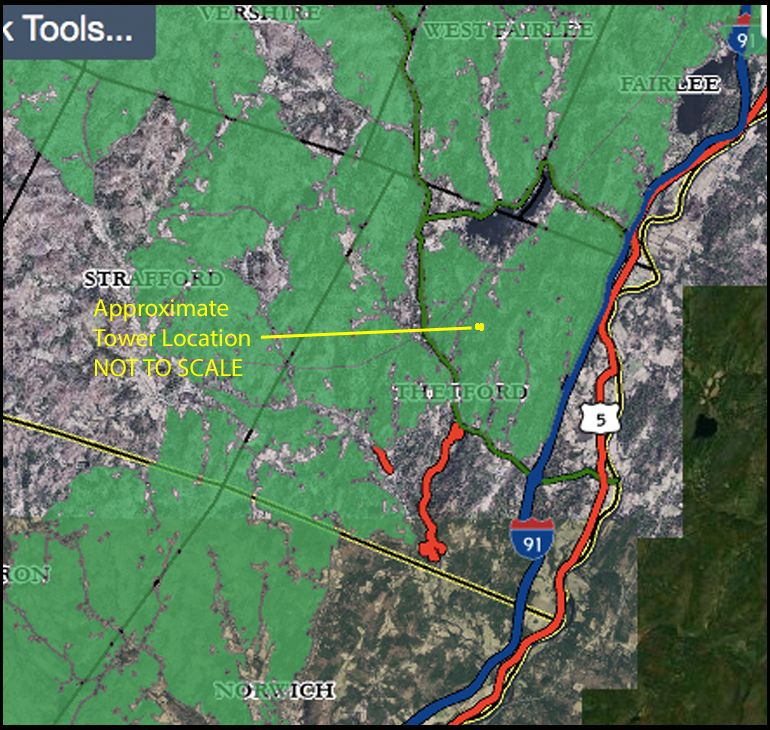ANR examines proposed tower site for ecological impacts
Vermont recognizes the value of its forested ecosystems.

Editor's Note: Li attended the site visit as a member of the Selectboard.
On April 22nd a group of experts, including biologists from the Vermont Agency of Natural Resources (ANR), Vermont Fish and Wildlife Department, and a consulting biologist from AT&T, made a site visit to the location of the proposed AT&T communications tower on the Thetford Town Forest. Also present were Mike Scruggs and David Goodrich, representing the Upper Valley Fish and Game Club, as well as the lawyer representing AT&T and the Site Acquisition expert from Center Line Communication. At issue was whether—or how much—would the tower and its attendant service road affect important ecological resources.
Eric Sorensen, an ecologist with Fish and Wildlife, voiced a concern that the tower site is situated within an important interior forest block. (The first proposed site on Sawnee Bean Road is also within an interior forest block.)
Interior forest blocks provide many ecological and biological functions critical for protecting native species and the integrity of biological systems. These include: supporting natural processes such as predator-prey interactions and natural cycles of disturbance; maintaining air and water quality and flood resilience; allowing the survival of many plant and animal species, particularly those that are wide-ranging or sensitive to human encroachment; supporting viable populations of wide-ranging animals by allowing them to move between important feeding habitats, and undergo reproduction and genetic exchange; and serving as a healthy reservoir of animals for recolonization of nearby habitats that may have become depopulated.

He noted that the southern end of the Town Forest in particular is an important contributor to a regional wildlife connectivity corridor that permits animals to move between the White Mountains of New Hampshire and the Green Mountains of Vermont and beyond. The tower and its gravel road make a permanent hole in the forest that impinges on this corridor, unlike logging clearings and skid roads that are temporary. Trails and roads have the undesirable effect of allowing predators to easily gain access to the forest interior, to the detriment of species that only live in such forest, such as birds like the black-throated blue warbler and scarlet tanager. Another problem encouraged by forest roads is the parasitic cowbird that lays its eggs in the nests of warblers and other songbirds. At least the road to the tower would be a dead-end road and would not cause fragmentation of the forest into smaller blocks—the very damaging legacy of roads that connect.
The group also examined a vernal pool that is 130 feet from the tower site. The pool contained eggs of the spotted salamander, an amphibian that mostly lives underground but migrates to such pools to breed. Vertical road edges and other man-made barriers like silt fences can be insurmountable obstacles to migrating salamanders. While spotted salamanders are still common in Vermont, their numbers are declining. In absence of State rules governing vernal pools, it is likely that this pool would get a buffer zone of 50-100 feet, analogous to a Class 2 wetland. (There are up to three potential vernal pools and one verified vernal pool in the vicinity of the first proposed site on Sawnee Bean Road.)
There was discussion of the number of vehicles that would use the access road. In general each carrier that has an installation on a tower might come to inspect it once a month. However it was noted that there are fewer visits to rural towers.
As we learned previously, there will be no lights on the tower. Utilities to the tower will be buried, and there will be no transformer boxes. Since a small clump of trees will be removed for the tower, it is likely that AT&T would draft a tree clearing plan.
While it seems unlikely that the findings of this visit will be a huge game-changer, it will serve as a reminder to AT&T to proceed carefully. Vermont recognizes the value of its forested ecosystems.
